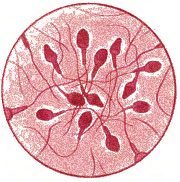Sperm Mapping™ in Los Angeles & San Francisco, CA

A Minimally Invasive Approach to Finding Sperm
You may be inclined to give up all hope of conceiving after learning that you are “sterile,” but that diagnosis does not have to be the end of your fertility journey. Male infertility expert Dr. Paul Turek has helped thousands of patients to find “hidden” sperm that can be used to produce a child. Sperm mapping™ technology shows incredible promise for men that have been told they are infertile due to non-obstructive azoospermia (i.e., a lack of sperm in the ejaculate). Developed by Dr. Turek, the minimally invasive technique can find sperm in areas of the testes that may have gone unnoticed during conventional sperm extraction procedures.
Sperm mapping™, also known as “FNA mapping” or “testicular mapping,” helps men with the most severe forms of infertility, including cancer survivors, become biological fathers. It acts as “GPS” for the testicle, guiding sperm retrieval with precision. Following the principle of “knowing before you go,” if sperm is found through mapping, the retrieval may not require TESE surgery and could instead be performed with a less invasive aspiration technique like TESA. Ideally, men should have sperm mapping™ before undergoing any type of sperm retrieval surgery, ensuring the best possible approach is taken from the start.
In a recently published study of the sperm mapping™ technique, Dr. Turek found sperm in one-third of men who had failed microdissection testicular sperm extraction (microTESE) procedures. He has also published that sperm mapping™ can find hidden sperm in as many as 45% of men who have failed conventional testicular sperm extraction procedures (TESE).*
If you have a diagnosis of non-obstructive azoospermia, there is hope. Dr. Turek invites you to schedule a consultation with him to discuss your options
Understanding Azoospermia
When a man has no detectable amount of sperm in his semen, the condition is called azoospermia. Azoospermia affects 1 in 100 men and is responsible for as many as 10% of the total cases of male fertility. Obstructive azoospermia describes men who produce sperm normally, but the sperm outflow is blocked in some manner from reaching the ejaculate. Non-obstructive azoospermia is when sperm are not produced normally or not at all and can be attributed to a number of causes (genetics, disease, hormonal imbalance, testicular failure) other than blockage. Sperm mapping™ is most beneficial for patients who have non-obstructive azoospermia but can also help distinguish whether a man has obstructive or nonobstructive azoospermia. In fact, it surpasses the traditional testis biopsy in its ability to distinguish between these two conditions, and is less invasive and has fewer complications than a testis biopsy procedure.
An Overview of Sperm Mapping™

Sperm mapping™ is based on the fine needle aspiration (FNA) technique, which is currently very popular in many other areas of medicine. After numbing the scrotum, Dr. Turek collects tiny (1/10 of a drop) tissue samples from all areas of the testicles through the skin using small needles. Heuses a grid-like template for collection to ensure that the entire testis is examined .The samples are stained and then precisely and systematically examined for hours under a microscope for the presence of sperm. Since the found sperm are stained, they are not usable for assisted reproduction, which means that FNA mapping is an entirely diagnostic technique. The results help Dr. Turek to create a sperm map™ showing where sperm can be found with a future sperm retrieval.
FNA sperm mapping™ takes about 45 minutes and can be performed in Dr. Turek’s office with local anesthesia (with the option for sedative medication). There is no need for an operating room or an anesthesiologist. The procedure is minimally invasive and incision-free, with very little pain. Patients are allowed to return to normal activity within a day or two.
When other methods for locating sperm come up short, sperm mapping™ is an incredibly simple but very cutting edge and thorough way to know more confidently whether any sperm is present in the testicles that might be used for assisted reproduction.
Optimizing the Sperm Retrieval Process
Like a GPS system that maps out the most efficient route on a long drive, sperm mapping™ not only tells Dr. Turek whether the testes are producing sperm, but also where it is located and how much is present. He can later go back and use the “map” to retrieve the sperm so it can be used for in vitro fertilization (IVF) and intracytoplasmic sperm injection (ICSI) for pregnancies.
The information Dr. Turek gathers during sperm mapping™ has been demonstrated to make sperm retrieval procedures faster, less invasive and more comfortable. As it takes the guesswork out of the process, it is much more efficient than any other method. If sperm is located in the map, retrieval can be planned using the least invasive method possible, whether it be TESA, TESE, or another approach.
Other Advantages of Sperm Mapping™ over Traditional Techniques
Many sterile men undergo testicular biopsies to evaluate their candidacy for being biodads. These are painful and involved procedures in which testicular tissue is removed by surgical biopsy. Sutures are necessary to rejoin the skin and testicles at incision points. Some patients experience swelling, bleeding, infection and/or discoloration of the scrotum. The removed tissue is examined under a microscope to determine if a blockage is the source of fertility issues or if testicular sperm are present.
In addition to being better at finding sperm, sperm mapping™ has a significantly shorter and easier recovery than traditional biopsy techniques. Men experience less discomfort after the procedure and can get back to their normal daily activities far more quickly.
Sperm mapping™ is also better for the long-term health of the testis because it conserves as much tissue as possible. Traditional “blind” testicular procedures are more involved in that they require numerous, much larger biopsies and remove significantly more testicular tissue which can jeopardize testosterone levels (since testis biopsy procedures also indiscriminately remove the testosterone-producing Leydig cells from the testicle). Recent research has confirmed that microTESE carries a significant risk of testosterone impairment that may result in the need to take testosterone for life. This study highlights the importance of preserving as much healthy testicular tissue as possible when searching for sperm.
Sperm mapping™ is beneficial from a cost standpoint as well. Sperm retrieval and IVF-ICSI are expensive procedures, so it makes sense to know in advance of undergoing them whether sperm will be found in the testes. Notably, if nothing is found with sperm mapping™, then sperm retrieval procedures can safely be skipped altogether and IVF avoided as there is a less than 1% chance that sperm was missed by this technique.
On the contrary, Dr. Turek’s success rate at retrieving sperm that is previously identified with sperm mapping™ is 95%-100%. This means that IVF can be confidently pursued using fresh testicular sperm without the need for having “backup” donor sperm, or freezing unfertilized eggs, or canceling IVF cycles after they have been started. Patients who pursue “blind” sperm retrievals without advanced knowledge of sperm presence provided by sperm mapping™ will need to consider having “backup” plans for IVF and sperm in 50% of cases.
The Turek Clinic Difference
Most doctors offer blind and aggressive microTESE procedures for men with azoospermia, telling patients this is their best or only option for discovering hidden sperm. Many of these men come to us after failed microTESE procedures, unaware that sperm mapping™ was an option. Dr. Turek has helped hundreds of these men become biodads by finding sperm using FNA mapping™ after failed procedures at other clinics and has actually published his success in these scenarios.
Dr. Turek offers sophisticated mapping techniques that allow him to locate sperm in the testicles in advance rather than blindly going into large surgical procedures, hoping to find sperm when eggs are retrieved with IVF. Sperm mapping removes the guesswork for finding sperm and achieves a much higher overall success rate: 95-100%! As Dr. Turek states, “Nothing beats knowing before you go!”
The Many Advantages of Sperm FNA Mapping
| Unguided Microdissection | Sperm Retrieval After Sperm FNA Mapping | |
|---|---|---|
| Retrieval Success | 50% of men will have sperm with blind microTESE and 50% will not. So, half of men have unnecessarily invasive procedures. | If FNA mapping finds sperm, sperm retrieval procedures find sperm in 92-100% of cases. |
| Invasiveness | Blind procedures are more extensive and invasive and pose greater risks for “damaging” the testicles. A lower testosterone level is the most concerning risk from microTESE procedures. | By identifying where sperm is hiding before performing sperm retrieval surgery, Dr. Turek can avoid microTESE sperm retrieval procedures in 50% of cases (using TESA/TESE instead). |
| Finding Sufficient Sperm | Unguided microTESE finds sperm in half of attempted cases. Most doctors consider finding 1-2 sperm to be “success.” | Aided by sperm mapping, Dr. Turek has a 92-100% success rate at retrieving enough sperm to fertilize all eggs with IVF. |
| Avoiding More Invasive Microdissection Techniques | If you don’t know where sperm are within the testis, a microTESE is needed to find sperm pockets. However, it is the most aggressive form of surgical sperm retrieval. | After FNA mapping, half of all patients can skip microTESE in favor of a less invasive TESA or TESE procedures. Furthermore, 80% of patients need procedures on only one testicle rather than both. |
| Less Anxiety | Given the uncertainty surrounding microTESE, many patients wind up having to freeze eggs or use donor sperm as a backup. | Knowing that the chance of finding sperm is very high, patients can schedule a fresh sperm retrieval along with IVF with low chances of needing a backup plan. |
| Confidence in Results | Given that FNA mapping can find usable sperm in 30% of patients who have no sperm on microTESE, many patients wind up trying guided sperm mapping next anyway. | Sperm mapping results are conclusive. Of Dr. Turek’s patients where FNA mapping found no hidden sperm, fewer than 1% have sperm found by any other method. |
Learn More about Sperm Mapping™ from Dr. Paul Turek
Sperm mapping™ has helped thousands of men facing infertility realize their dreams of building a family. The power of this technology was most recently demonstrated in a published study by Dr. Turek of over 80 men from around the world who underwent sperm mapping™ after failing large microdissection testicular sperm extraction procedures. Dr. Turek found hidden sperm in almost 1/3 of these men. Upon targeted sperm retrieval procedures in these mapped men, sperm were found in all cases and excellent pregnancy and birth rates achieved. These fantastic results have led to Dr. Turek being hailed as the “Sperm Whisperer” by his colleagues in the field.
To discuss sperm mapping™ with internationally renowned male infertility expert Paul Turek, M.D., please contact The Turek Clinic today.
Sperm Mapping FAQs
How do I prepare for a sperm mapping session?
Preparing for a sperm mapping session involves several steps to ensure the procedure is successful. Our team will review any lifestyle issues, (e.g hot baths or tubs, saunas), medications or supplements you are taking, as some may need to be temporarily discontinued ahead of the treatment. This will be part of a larger review of your medical history/allergies. A recent history of illness with fevers can be a reason to postpone the procedure. The procedure is minimally invasive, so fasting is not required, but wearing comfortable clothing on the day of the session is recommended.
Is sperm mapping covered by insurance?
Hidden sperm mapping is considered an advanced fertility diagnostic procedure and may not be universally covered by insurance plans. Coverage varies depending on the specifics of your insurance policy and your provider’s guidelines. We advise patients to contact their insurance provider directly to confirm whether sperm mapping is included in your plan. If it is not covered, our clinic offers financing options to help manage the cost.
Are there any risks or side effects associated with sperm mapping?
While any medical intervention carries risks, sperm mapping is considered a very safe procedure since it is minimally invasive. The procedure involves fine needle aspiration (FNA) from multiple sites within the testicles, which may result in minor discomfort, bruising, or swelling at the biopsy sites. Fortunately, these side effects are typically mild and resolve quickly. In over 2000 cases performed to date, there have been no cases of infections, bleeding, loss of testis or chronic pain after FNA mapping. The Turek Clinic will provide detailed post-procedure care instructions to minimize all potential risks.
Can hidden sperm mapping detect genetic abnormalities?
Sperm mapping is designed to locate and quantify the presence of sperm within the testicles for men with azoospermia (no sperm in the ejaculate). While it is an effective tool for diagnosing the presence and location of sperm, it does not directly detect genetic abnormalities. It is also reassuring to know that sperm are not genetically altered by sperm mapping or any of the subsequent procedures used to retrieve sperm for IVF.
What happens if no sperm are found during mapping?
If no sperm are found during sperm mapping, it may indicate a more severe form of azoospermia, where sperm production is extremely limited or absent. In such cases, Dr. Turek will discuss alternative options with you, which may include making lifestyle changes, fixing clinical varicoceles or taking cutting edge medical advice based on his emerging research. Donor sperm and embryo and child adoption are other options to consider as stem cell-based therapy for this condition is not ready for clinical use. A detailed consultation will be scheduled to discuss the next steps and potential treatment pathways.
Can sperm mapping be repeated if necessary?
For most patients, a single treatment is sufficient to determine whether sperm is present in men with non-obstructive azoospermia. That said, sperm mapping can be repeated if necessary. In some cases, repeating the procedure may be recommended if the initial mapping reveals no sperm — but only if there are correctable or reversible reasons for this (e.g. varicocele, hormonal issues) and those issues are rectified. The procedure’s minimally invasive nature makes it feasible to perform numerous times, though Dr. Turek will evaluate the benefits of repeating the mapping based on your specific situation.









